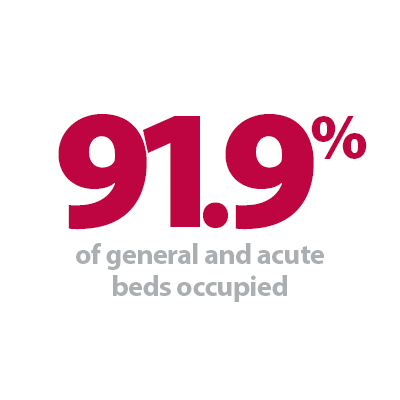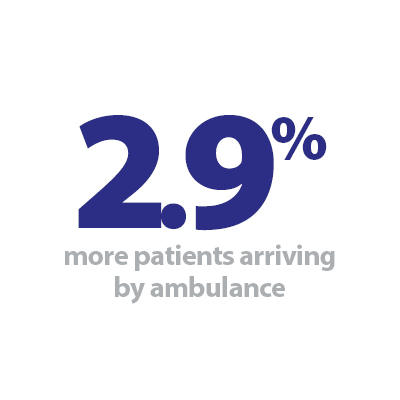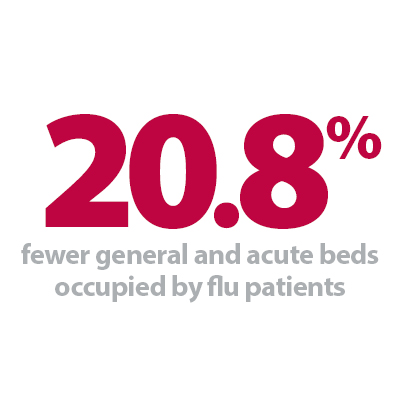


Today we saw the seventh week of the winter sitreps published by NHS England and NHS Improvement. The downward trend in COVID-19 cases and the corresponding impact on hospital activity is encouraging but we are still seeing high numbers of patients in hospitals, as well as elevated staff absences with almost half of those being due to COVID-19.
Recent data (19 January) registered a total of 96,545 cases in England, a figure down by 16.9% since the week before. Equally, the number of new hospital admissions (1,808) and patients in hospital (15,742) are down from the week before, even though they remain elevated. Additionally, staff absence levels are remarkably higher than the beginning of December: latest data showed some decreases, but there was an average of 72,217 total absences this week, of which 46% were COVID-19 related (35,555).
Despite the fall in COVID-19 cases nationally, pressures remain intense in the health service, with this week's data highlighting some of the current concerns on the ground.
Key headlines from winter sit reps (10 January – 16 January):
- Pressures continue to be felt in ambulance services, with a 2.9% increase in the number of patients arriving by ambulance this week (83,492 total arrivals).
- Ambulance handover delays have fallen by nearly five percentage points this week, but 17.9% of ambulance handover delays were still 30 minutes or more. The number of handover delays of 60 minutes or more also fell slightly from 9.8% to 6.7% this week, but both remain higher than the same time last year.
- Adult critical care bed occupancy has decreased slightly since last week to 76% and is now lower than the same time last year (86.5%). The average number of critical care beds open in week seven is 16% lower compared to the same week last year.
- Adult and paediatric general and acute (G&A) bed occupancy was relatively stable at 91.9% (from 91.8% last week). The adult G&A bed occupancy rate was stable at 93.4%, higher than this time last year (87.2%), even though this week saw more beds open than the week before (399 more). Compared to last year, there were 1,399 fewer beds open this week.
- Paediatric intensive care bed occupancy was slightly up from 73.6% to 74.5% this week, remaining higher than the same time last year (67%), whereas the average number of beds open is 10.1% higher compared to the same time last year. As for neonatal intensive care beds, we saw a slight decrease of 0.3 percentage points to 69.3% this week, but this figure remains higher than last year (65.6%) even though the average number of beds open is 5.3% higher from that time.
- The number of patients staying in hospital longer than seven days has fallen for the first time since the start of this winter's sitreps, with 349 fewer patients staying in hospital longer than seven days compared to the week before (0.8% less). However, the number of those staying longer than 14 and 21 days has continued to increase and is up by 2.6% and 3.7%, respectively.
- The number of beds closed due to diarrhoea and vomiting (D&V) and norovirus has also reached its lowest level since the start of this winter's sitreps (32.9% fewer beds closed, averaging 107 beds closed per day) yet remains considerably higher than the same time last year (22).
- Another observed fall was in the number of G&A beds occupied by flu patients, now at 252 (a decrease of 20.8%), but data showed that a total of 29 critical care beds were occupied by flu patients this week (10 more).
- The number of delayed discharges continues to be concerning: on 16 January there were 17,598 patients who no longer met the criteria to reside, of which 73% (12,767) remained in hospital, a figure slightly up from 72% last week.
The figures from this week show some slight improvements but they also highlight how trusts are still operating under remarkably challenging circumstances. This week we saw once again high rates of general and acute bed occupancy, as well as paediatric and neonatal intensive care bed occupancy, despite the increases in the number of beds open compared to last year.
Similarly, there was an increase in the number of patients staying in hospital longer than 14 and 21 days, and more patients arriving by ambulance. These figures highlight the increased demand services are currently experiencing across the urgent and emergency care pathway, alongside other seasonal pressures, COVID-19 care needs and, of course, the ongoing vaccination programme. Another concerning figure pertains to the number of delayed discharges, which is indicative of system wide pressures including those in social and community care. We also know from our members that these pressures extend to mental health services.
Encouragingly, however, this week's data show fewer ambulance handover delays, a reduction in the number of beds closed due to D&V and in the number of beds occupied by flu patients, as well as decreases in staff absences even though they remain much higher than the levels seen in early December.
These latest data show some promising improvements but also underline the reality of the pressures trusts are facing at the moment on the ground, with increased demand and challenging staff shortages alongside the ongoing impact of the Omicron wave.
Why have we decided to become a direct provider of social care?
Sir Jim Mackey, chief executive of Northumbria Healthcare NHS Foundation Trust, shares why his trust has become a direct provider of home care services in North Tyneside and Northumberland, creating up to 250 jobs in the process.
In the middle of another tough winter, with the usual pressures exacerbated by the latest wave of the pandemic, flow continues to be one of the key areas of focus to ensure we can continue to provide the right care for our patients in the right places.
Maintaining flow is one of those areas which highlights very clearly how important it is that we have a strong and resilient health and care system, with all aspects working together effectively and efficiently. This obviously includes social care and that's why we have taken the decision to become a direct provider of home care services in North Tyneside and Northumberland, creating up to 250 jobs in the process.
At a time when understanding about the need for seamless integration of health and care services has never been higher, we are moving forward with our proposal to provide domiciliary services while also considering the development of care homes, based on our established patient-focused approach to high-quality care. Through this important step, we will work with existing care providers to ensure that the system works as well as it can for communities in our area. We are also aware that other trusts are working on similar schemes and will be sharing our experience and working with them as well. I am sure that there is a lot we can learn from each other along the way. Once fully established, the service could employ up to 250 people and a recruitment process has just started for the first wave of 25 staff, including a manager to oversee the delivery of home care services.
Our colleagues in the care sector have worked as hard as our teams in the NHS during a period of unprecedented pressure through the COVID-19 pandemic, and we thank them for their efforts. However, we know that there is unmet demand in our communities, which is unsurprising given the growing need nationally for more social care provision. We also know that home care is a fragile market, and becoming more fragile over time. Therefore, an opportunity has arisen for us to use our expertise to help support the care sector in Northumberland and North Tyneside. Having effective social care services is vital to the entire health system, because to allow the region's hospitals to cope with the demand from new patients coming in, we need to be able to move on those patients who no longer need hospital care in order to free up beds.
Through our new service, we can boost the system by adding further provision, ensuring that more people in need of home care can be allocated the support they need through the usual processes. As always, our focus will be on quality and making sure that these services are completely tailored to the needs of the people who use them, and also being first-class services to work in. The new roles are a unique chance for people to develop their careers, at a time when we are moving ahead with our ambition for the Northumbria Health and Care Academy, a training centre of excellence, which received planning permission before Christmas and supports our goal of growing the workforce by ensuring people have the right skills.
It is not in our interest, in any way, to simply take existing staff from elsewhere in our area's system, which is why this is not something we are looking at as a short-term fix. This is part of a longer-term process to support a robust health and care system in Northumberland and North Tyneside, ensuring that people see care roles as part of that system with the potential for more wide-ranging career development. This exciting plan also supports Our Community Promise – our commitment to do even more to support our population – as it will create new jobs, support education and training for carers, and open up further employment opportunities, for example, apprenticeships.
We expect to have our home care offer up and running in a matter of months, which could be followed by care home provision in the coming financial year.
Slight improvements this week, but the NHS is still at full stretch
Responding to the latest week of winter reporting data, from NHS England and NHS Improvement, the director of policy and strategy at NHS Providers, Miriam Deakin said:
"These figures once again highlight how intense pressures are in the health service, despite the fall in COVID-19 cases nationally.
"There are welcome indications that things are improving in terms of workforce absences, with total staff absences decreasing by nearly a fifth. However, these figures are still much higher than at the start of December, when Omicron first took grip in the community.
"Fewer ambulances were delayed this week when handing over patients to emergency departments, a positive sign given the number of people arriving to hospital by ambulance has also increased. However, both ambulance activity and handover delays remain higher than this time last year.
"Meanwhile, the number of people staying over a week in hospital has also improved for the first time this winter, but more people are staying longer than 14 and 21 days. Additionally, the number of adults occupying a critical care bed has decreased slightly since last week, but overall beds occupied is still at a very high level.
"The number of delayed discharges also continues to be concerning, indicating real pressure across the system, including in community and social care.
"So while there have been slight improvement this week against some of the data indicators across urgent and emergency care, there is still lots of evidence that the health service is at full stretch. We must also recognise that the asks for trusts on recovery are much wider than encapsulated here.
"And while the government has announced an easing of COVID-19 restrictions, they must continue to keep an eye on the pressures in the NHS, the scale of the challenge ahead to recover from the pandemic, and make calculations based on the future level of risk."